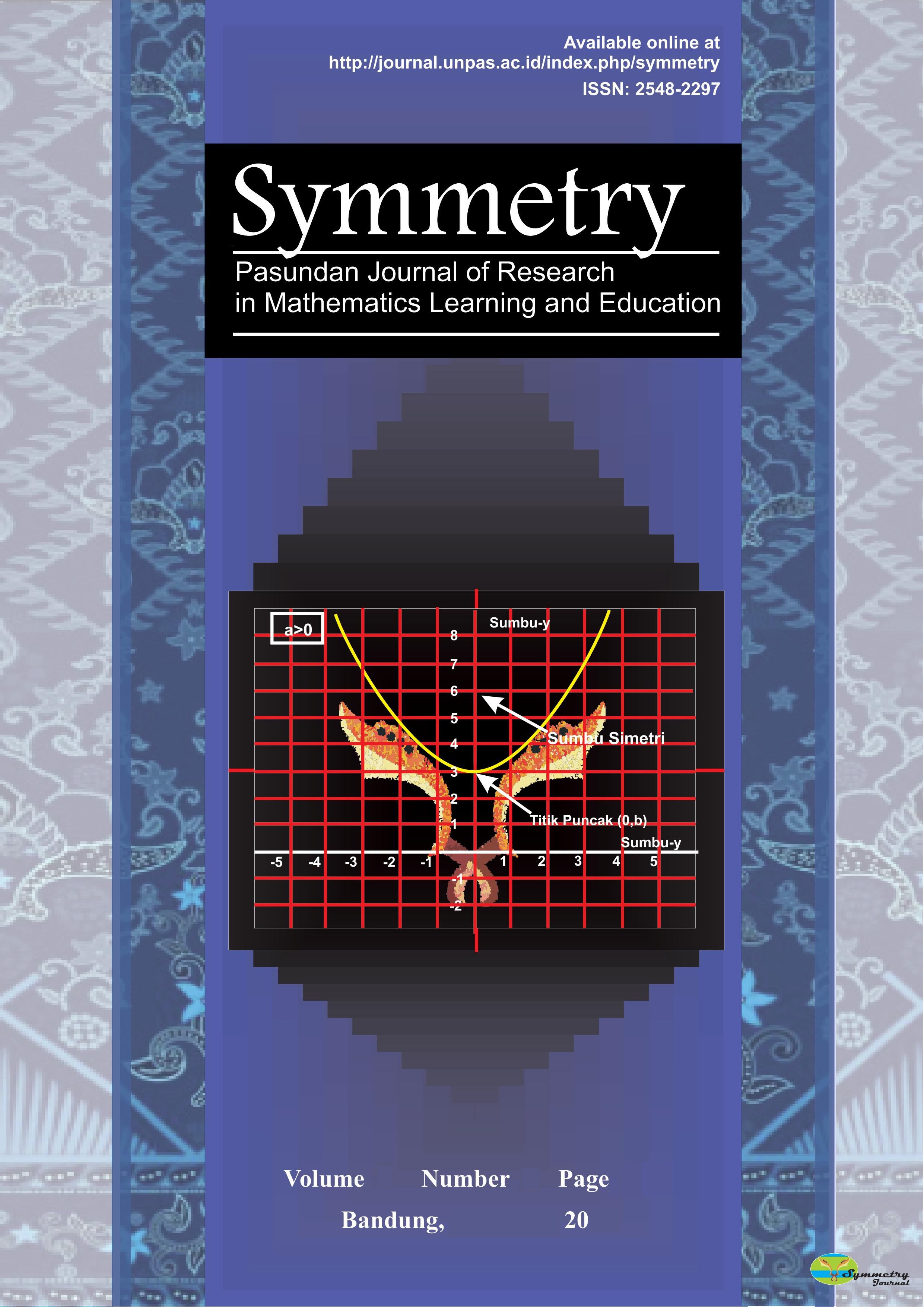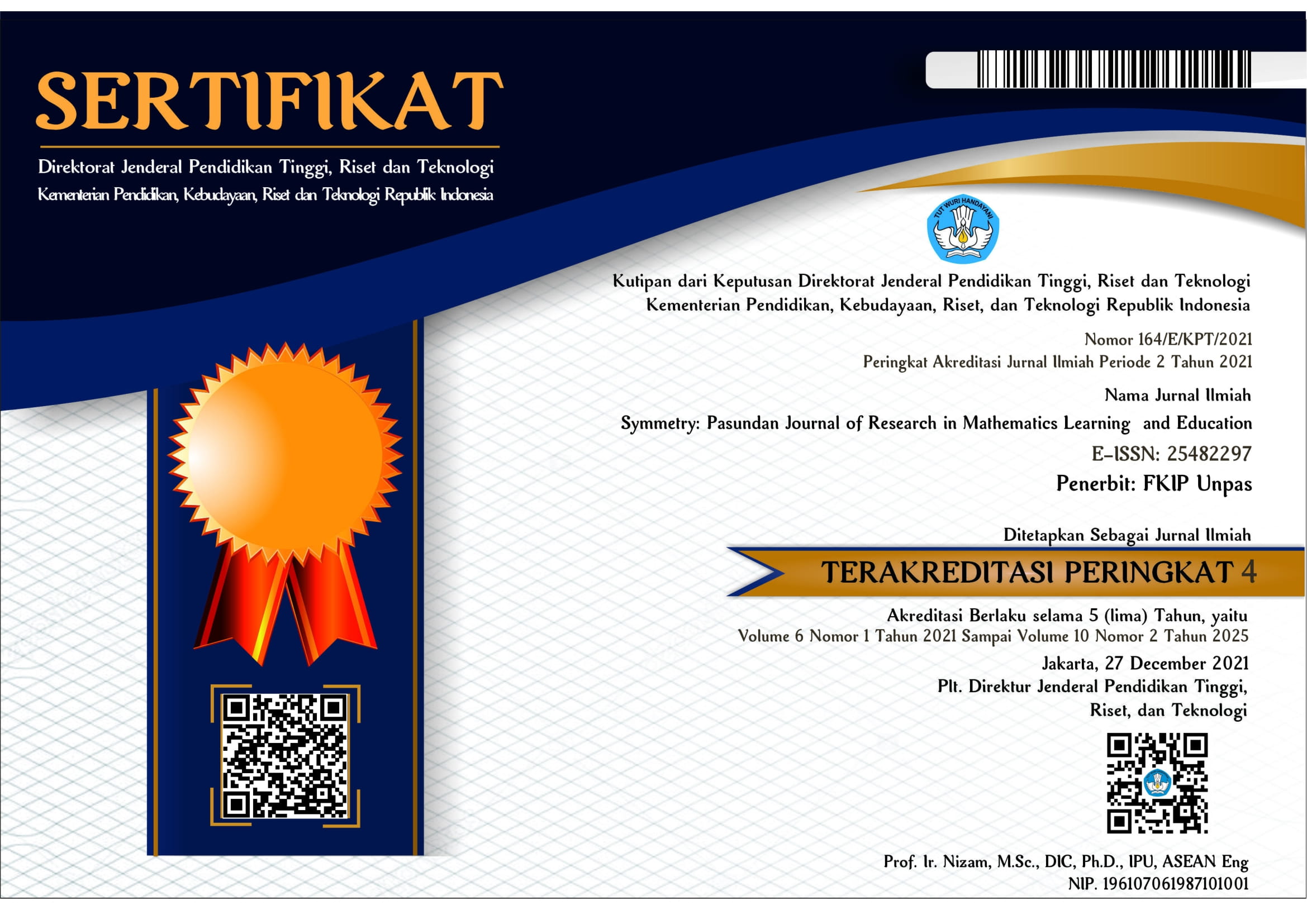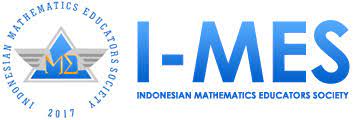Exploring Grade 11 Learners’ Mathematical Connections when Solving Trigonometric Equations
DOI:
https://doi.org/10.23969/symmetry.v8i1.7344Keywords:
Trigonometric Equations, Links, Nodes, Algebraic Connections, Trigonometric ConnectionsAbstract
In this paper, we explored the intra-mathematical connections that grade 11 learners make when solving trigonometric equations. The study was guided by Mowat’s theory of mathematical connections in which nodes and links are used to connect mathematical concepts and topics. We used a qualitative case study design within an interpretive paradigm to explore the intra-mathematical connections learners make as they solved trigonometric equations. The study was conducted in a high school in Mankweng Circuit, Limpopo Province, South Africa. Convenience sampling was used to select 30 learners who participated in the study. Data was collected using documents and task-based interviews. Data were analysed using inductive thematic analysis. The findings showed that learners made were able to make algebraic connections when solving trigonometric equations. They, however, were unable to make connections within trigonometry itself. This study, therefore, recommends that teachers stress the importance of connections when teaching trigonometry so that learners will not learn trigonometric concepts in isolation. In addition, it is recommended that further research be conducted on teaching strategies to improve learners’ mathematical connection skills when solving trigonometric equations.
Downloads
References
Adhikari, T. N., & Subedi, A. (2021). Difficulties of Grade X students in learning Trigonometry. Siddhajyoti Interdisciplinary Journal, 2(01), 90-99.
Ayunani, D. S., & Indriati, D. (2020, April). Analyzing mathematical connection skill in solving a contextual problem. Journal of Physics: Conference Series, 1511(1), p. 012095). IOP Publishing.
Barabasi, A. L. (2003). Linked: How everything is connected to everything else and what it means. Plume.
Braun, V., & Clarke, V. (2006). Using thematic analysis in psychology. Qualitative research in psychology, 3(2), 77-101.
Chigonga, B. (2016). Learners’ Errors When Solving Trigonometric Equations and Suggested Interventions from Grade 12 Mathematics Teachers. International Society for Technology in Education, 163–176. https://www.researchgate.net/publication/314285050_Learners’_errors_when_solving_trigonometric_equations_and_suggested_interventions_from_Grade_12_Mathematics_teachers
Cichon, D., & Ellis, J. G. (2020). The effects of MATH Connections on student achievement, confidence, and perception. In Standards-based school mathematics curricula (pp. 345-374). Routledge.
Creswell, J. W., & Poth, C. N. (2016). Qualitative inquiry and research design: Choosing among five approaches. Sage publications.
Department of Basic Education. (2011). Mathematics Curriculum and Assessment Policy Statement. Pretoria: Department of Basic Education.
Department of Basic Education. (2020). Report on the National Senior Certificate Examination: National diagnostic report on learners’ performance.
Department of Basic Education. (2021). Report on the National Senior Certificate Examination: National diagnostic report on learners’ performance.
Doll, W.E. (2010). What’s so special about a special issue? Complicity: An International Journal of Complexity and Education, 7(1), 2-6.
Eli, J. A., Mohr‐Schroeder, M. J., & Lee, C. W. (2013). Mathematical connections and their relationship to mathematics knowledge for teaching geometry. School Science and Mathematics, 113(3), 120-134.
Ernaningsih, Z., & Wicasari, B. (2017). Analysis of mathematical representation, communication and connection in trigonometry. International conference on research in education, 45-57.
Evans, S., & Swan, M. (2014). Developing students’ strategies for problem solving in mathematics: The role of pre-designed “Sample Student Work”. Educational Designer, 2(7).
Fahrudin, D., & Pramudya, I. (2019, March). Profile of students’ errors in trigonometry equations. In Journal of Physics: Conference Series, 1188(1), p. 012044). IOP Publishing.
Garcia-Garcia, J., & Dolores Flores, C.D., (2019). Pre-university students’ mathematical connections when sketching the graph of derivative and antiderivative functions. Mathematics Education Research Journal.
Garcia-Garcia, J., & Dolores Flores, C.D., (2020). Exploring pre-university students’ mathematical connections when solving Calculus application problems. International Journal of mathematical education in science and technology, 1-21.
Hafiz, M., Kadir & Fatra, M. (2016). Concept mapping learning strategy to enhance students’ mathematical connection ability. Mathematics, Science, and Computer Science Education Conference Proceedings, 040006-1–040006.
Jailani, J., Retnawati, H., Wulandari, N. F., & Djidu, H. (2020). Mathematical literacy proficiency development based on content, context, and process. Problems of Education in the 21st Century, 78(1), 80.
Jingga, A.A., Mardiyan, M., & Triyanto, D.N. (2019). Mathematical connections made by teacher in Linear program: An Ethnographical study. Journal of educational and social research, 9(2), 25-34.
Kamber, D., & Takaci, D. (2018). On problematic aspects in learning trigonometry. International Journal of Mathematical Education in Science and Technology, 49(2), 161-175.
Kenedi, A.K., Helsa, Y., Ariani, Y., Zainil, M., & Hendri, S. (2019). Mathematical connection of elementary school students to solve mathematical problems. Journal on Mathematics Education, 10(1), 69-80.
Kleden, M. A., Sugi, Y., & Samo, D. D. (2021). Analysis of Mathematical Connections Ability on Junior High School Students. International Journal of Educational Management and Innovation, 2(3), 261-271.
Maphutha, K., Maoto, S., & Kibirige, I. (2022). The Effect of the Activity-Based Approach on Grade 11 Learners' Performance in Solving Two-Dimensional Trigonometric Problems. EURASIA Journal of Mathematics, Science and Technology Education, 18(10).
Martín-Fernández, E., Ruiz-Hidalgo, J. F., & Rico, L. (2019). Meaning and Understanding of School Mathematical Concepts by Secondary Students: The Study of Sine and Cosine. EURASIA Journal of Mathematics, Science and Technology Education, 15(12).
Merriam, S. B. (1998). Qualitative Research and case study: Applications in Education. San Francisco, CA: JosseynBass.
Mosese, N., & Ogbonnaya, U. I. (2021). GeoGebra and students’ learning achievement in trigonometric functions graphs representations and interpretations. Cypriot Journal of Educational Sciences, 16(2), 827-846. https://doi.org/10.18844/ cjes.v16i2.5685
Mowat E, E., & Davis, B. (2010). Interpreting embodied mathematics using Network Theory: Implications for mathematics education. Complicity: An International journal of complexity and education, 7(1), 1-31.
Mowat, E. (2008). Making connections: Mathematical understanding and network theory. For the Learning of Mathematics, 28(3), 20-27.
Mutodi, P., (2016). Exploring Grade 11 learners’ approaches for solving trigonometric equations. Department of Mathematics, Science and Technology Education, University of Limpopo South Africa.
Nabie, M. J., Akayuure, P., Ibrahim-Bariham, U. A., & Sofo, S. (2018). Trigonometric Concepts: Pre-Service Teachers' Perceptions and Knowledge. Journal on Mathematics Education, 9(1), 169-182.
Ngcobo, A. Z., Madonsela, S. P., & Brijlall, D. (2019). The teaching and learning of trigonometry. The Independent Journal of Teaching and Learning, 14(2), 72-91.
Ngu, B. H., & Phan, H. P. (2020). Learning to solve trigonometry problems that involve algebraic transformation skills via learning by analogy and learning by comparison. Frontiers in Psychology, 11, 558773.
Nurmeidina, R., & Rafidiyah, D (2019). Analysis of learners’ difficulties in solving trigonometry problems.1-10
Pambudi, D. S., Budayasa, I. K., & Lukito, A. (2020). The role of mathematical connections in mathematical problem-solving. Jurnal Pendidikan Matematika, 14(2), 129-144.
Putri, A.G.E., & Wutsqa, D.U. (2019). Learners’ mathematical connection ability in solving real-world problems. Journal of Physics: Conference Series, 1320, 1-7.
Quiros., N.S. (2016). Extra-mathematical connections: Connecting mathematics and real world. 1-23.
Rahmi, M., & Subianto, M. (2020, February). First-grade junior high school students’ mathematical connection ability. In Journal of Physics: Conference Series (Vol. 1460, No. 1, p. 012003). IOP Publishing.
Richland, L. E., Stigler, J. W., & Holyoak, K. J. (2012). Teaching the conceptual structure of mathematics. Educational Psychologist, 47(3), 189-203.
Rodríguez-Nieto, C. A., Rodríguez-Vásquez, F. M., & Moll, V. F. (2022). A new view about connections: the mathematical connections established by a teacher when teaching the derivative. International Journal of Mathematical Education in Science and Technology, 53(6), 1231-1256.
Rohimah, S. M., & Prabawanto, S. (2019). Student’s difficulty identification in completing the problem of equation and trigonometry identities. International Journal of Trends in Mathematics Education Research, 2(1), 34-36.
Sarac, A., & Tutak, F. A. (2017). The relationship between teacher efficacy, and students' trigonometry self-efficacy and achievement. International Journal for Mathematics Teaching and Learning, 18(1).
Sarkam, S., Sujadi, I., & Subanti, S. (2019). Mathematical connections ability in solving trigonometry problems based on logical-mathematical intelligence level. Journal of Physics: Conference Series, 1188(1), https://doi.org/10.1088/1742-6596/1188/1/012022
Siregar, R., & Siagian, M. D. (2019, October). Mathematical connection ability: Teacher’s perception and experience in learning. In Journal of Physics: Conference Series (Vol. 1315, No. 1, p. 012041). IOP Publishing.
Siregar, N. D., & Surya, E. (2017). Analysis of students’ junior high school mathematical connection ability. International Journal of Sciences: Basic and Applied Research (IJSBAR), 33(2), 309-320.
Suominen, A. L. (2018). Abstract algebra and secondary school mathematics connections as discussed by mathematicians and mathematics educators. Connecting abstract algebra to secondary mathematics, for secondary mathematics teachers, 149-173.
Trihatun, S. (2019, October). Relationship between self-efficacy and mathematical connection ability of junior high school students. In Journal of Physics: Conference Series (Vol. 1320, No. 1, p. 012058). IOP Publishing.
Usman, M.H., & Hussaini, M.M. (2017). Analysis of students’ error in learning of trigonometry among senior secondary school students in Zaria Metropolis, Nigeria. Journal of mathematics,13(2), 1-4.
Yang, Z., Yang, X., Wang, K., Zhang, Y., Pei, G., & Xu, B. (2021). The Emergence of Mathematical Understanding: Connecting to the Closest Superordinate and Convertible Concepts. Frontiers in Psychology, 12, 525493.
Yosopranata, D., Zaenuri, Z., & Mashuri, M. (2018). Mathematical connection ability on creative problem solving with ethnomathematics nuance learning model. Unnes Journal of Mathematics Education, 7(2), 108-113.
Yumiati, S., & Haji, S. (2018). Ability of students’ mathematical connection based on school level in junior high school. Journal of Physics: Conference Series, 1-9
Zengin, Y. (2019). Development of mathematical connection skills in a dynamic learning environment. Education and Information Technologies, 24(3), 2175-2194.
Downloads
Published
Issue
Section
License
Copyright (c) 2023 Symmetry: Pasundan Journal of Research in Mathematics Learning and Education

This work is licensed under a Creative Commons Attribution 4.0 International License.
Hak Cipta sepenuhnya ditangan jurnal.




















